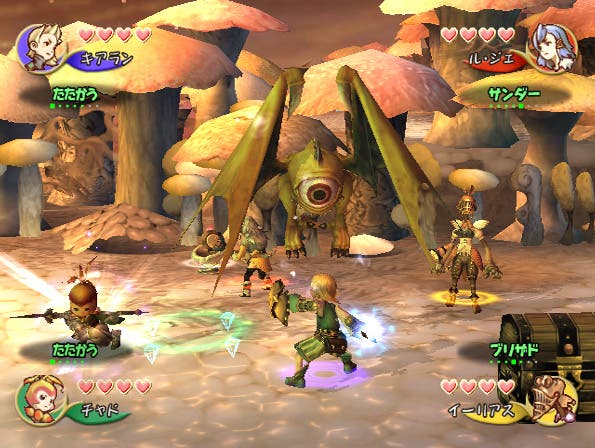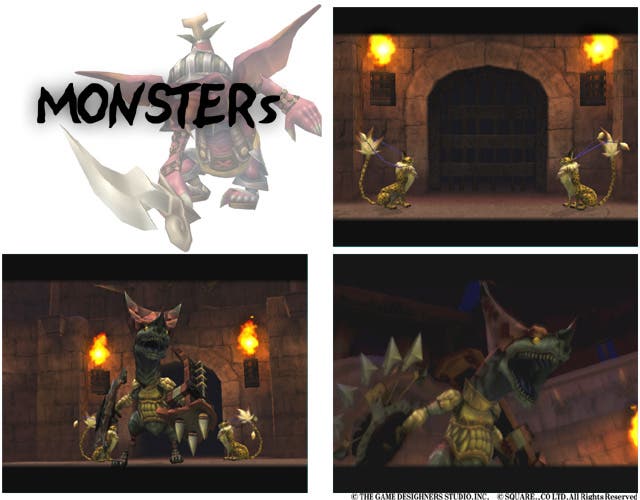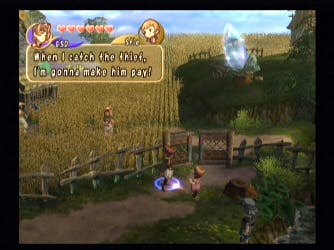Final Fantasy: Crystal Chronicles
Getting four GBA owning mates around a sofa to review this properly took months of planning, as Rob found out...
Connectivity. It's almost a dirty word for a lot of GameCube owners now; it's the battered old warhorse that Nintendo drags out at every E3 conference, every product demonstration, every game announcement. "Look," they cry in excitement, little Mario moustaches and Zelda Master Swords bouncing in excitement and wonder, "it connects up to your Game Boy Advance too! It's magic! The Nintendo Difference, I tell you!" And your eyes glaze over...
Unfair? Well, no, not really. In fact, for even some of Nintendo's most ardent fans, the very mention of GBA link functionality in Cube titles isn't just enough to precipitate a glazed expression - you'll get sighs, eyes rolled to heaven and the occasional angry rant about daft wastes of time. In short, the majority of Cube owners - among the vocal hardcore, at least - don't seem to be terribly enamoured with GBA connectivity.
This all came to a head when games started appearing that actually required that you hook up a GBA as a prerequisite to gameplay - particularly when Square Enix revealed that in order to play Final Fantasy Crystal Chronicles in four-player mode, you'd need four GBAs and four link cables. Howls of protest emanated from fans stricken at the prospect of requiring the guts of 500 quid's worth of hardware just to play a game.
But surely, if Nintendo is making such a big song and dance about connectivity, there must be something to it? Fans of the Kyoto based behemoth will point and wave endlessly at the many innovations which Ninty has introduced to the gaming world; so could it be that GBA connectivity really is something worth sitting up and taking notice of? Or is this truly another Virtual Boy moment for Miyamoto and company?
Only one way to find out - so clutching GBAs in one hand and GameCubes in the other (thank god for small consoles - try clutching an Xbox in one hand, eh?), we untangled our link cables, invited around some willing test subjects, put the cat out, and sat down to find out what two of the Cube's most hyped wonders of connectivity are actually like in the flesh. First up - Final Fantasy: Crystal Chronicles.
Late Bird Catches The Flak

It's interesting to note that the primary reason for the tardy nature of this review (read: my god, didn't this game come out months ago?) is exactly the same as the primary problem with the game as a whole. You see, way back when this review would have been on time, we played FF:CC for a significant amount of time single-player, and found it to be a diverting but ultimately terribly shallow Action RPG style distraction. A willing housemate was nabbed for a brief bit of two-player experimentation (stop sniggering at the back!), but this also proved unsatisfying - providing tantalising hints of deeper gameplay, but still definitely missing out on being a must-play experience by quite a long shot.
And so, before we could write with any level of conviction about Final Fantasy Crystal Chronicles, we had to get three like-minded individuals, with GBAs and the requisite number of link cables, in front of a GameCube for a fairly uninterrupted stretch of hours. Not, perhaps, a particularly difficult task for someone working in the offices of a game magazine or what have you - but for those of us living in the real world, this is a surprisingly tricky proposition, even when you have quite a few friends who enjoy games.
In fact, we've only managed to get groups together to play FF:CC a few times since the game arrived on these shores - Sunday evenings seem to be the best times, for some reason - and each time it has, we have to confess, been something of a chore to get the whole thing arranged and co-ordinated. It's a testament to Square Enix' game, then, that despite the hassle involved, we're desperately keen to get our party of adventurers together as often as possible - because once you do have those people all sat down around the Cube, what ensues is one of the most compelling multiplayer experiences ever.
Itinerant Lifestyle

Crystal Chronicles, as you'd hope, is decked out with all the production values we've come to expect from a high profile Square Enix title - stunning graphics, great music, a cohesive and well-imagined fantasy world, a vast range of items, characters and locations, and well-realised gameplay with plenty of intentional quirks and foibles to keep you interested for a significant period of time. Fears that the company might have trouble adapting to the new GameCube hardware were misplaced (although not exactly unfounded - remember the awful early Square titles on the PS2?), and the team has actually turned out one of the best-looking Cube titles ever, taking advantage of all manner of cunning graphical trickery that few other Cube third-party titles have ever exploited.
The character designs are in the "chibi" (cute and slightly child-like) mode, harking back to Final Fantasy IX in many respects - we'll leave it up to the reader to decide if this is a good thing or not, but suffice it to say that we liked Final Fantasy IX a great deal. In keeping with these designs, the world itself is quite cartoonish, with many clean lines and bright colours - but equally, it is by far the most graphically stunning world Square has ever built on a console, with incredible detail and gorgeous water, sky, fire and smoke effects (to name but a few) thrown about with gay abandon.
The basic idea behind the game is disarmingly simple. The entire world is shrouded in an evil fog which kills anyone who tries to walk through it - but the fog can be repulsed using certain magical crystals, which are powered by a substance called Myrrh which is harvested from specific trees. You and your band of merry companions form a "caravan", sent out to collect drops of Myrrh from these trees and return them to your village, so that the village crystal can be replenished. The caravan is protected from the fog by a smaller crystal, which is also what is used to store the Myrrh which you collect.
Mog, Mog Me Do

The basic game mechanics are simple - you traverse a world map in your caravan, moving between villages and dungeons, and when you enter a dungeon, you fight your way through to the end where you receive a drop of Myrrh. There are no random battles anywhere in the game - all enemies appear on the screen - and battles are conducted on the main screen, in real-time, in true action RPG fashion. You and your companions run around the screen bashing enemies with magic or weapons, picking up items and so on. Magic is equipped by picking up special magic spheres (you lose all of these when you leave the dungeon, and must start acquiring them again later) while statistic boosts to your character come from special items you acquire - one of which you can keep after you leave the dungeon, providing a form of levelling up but cunningly ensuring that even very "old" characters in the game can still play alongside newly created or imported characters without there being a huge disparity in ability.
The really clever thing about the game is that as you move around the dungeon, you are surrounded by a sphere of clear space in which you can move freely - outside which exists the fog which will kill you if you walk into it. This sphere is generated by a "bucket" which you must carry around with you - dropping it in order to fight monsters or pick up items, and then picking it up to move the safe area further into the map. At its most basic level, this simply ensures that all four players stay on the same screen rather than trying to run off to opposite ends of the map (in single player, a fluffy moogle character will carry your bucket for you). Where it gets more complex is when you consider the carnage that ensues from four players playing an action RPG together on the same screen.
After all, what are the chances of your designated bucket-carrier always remembering to pick the bucket up - especially if there's loot to be had elsewhere? Recognising this, Square decided to make the magical pick-ups spherical - and then gave them physics. So, while walking up to a magic sphere and tapping a button will pick it up, running full tilt into it will send it flying like a cue-ball across the surface of a snooker table, bouncing off obstacles and usually knocking itself out of the safe circle. Since you were probably running in the first place in order to grab the sphere before your teammates did, you then have to balance up the health damage with the worth of the sphere, making loot hunting into a risk-laden and often hilarious venture as self-interest and the magpie instinct override the need to act for the good of the team every time.
All In The Teamwork

That's where Square has really managed to make Crystal Chronicles into a fun, compelling experience. This isn't to say that there isn't plenty of interesting RPG type stuff going on in the background - you get a chance to cultivate relationships with various members of your family back in the village by sending them letters and presents, for example, which can make them more likely to help you out with items or cheap services. The equipment upgrade system revolves around an interesting cycle of finding designs and components for new gear and bringing them to the appropriate tradesman; while another interesting aspect is the fact that your character has personal preferences in food which influence how effective certain healing items are, and which change over time. Eat too many striped apples, and eventually you'll get sick of the sight of them and not want to touch any more. There aren't a lot of RPGs which make you keep a balanced diet (we often wondered how Alucard in Symphony of the Night kept his svelte figure despite eating all those pot roasts, actually)...
However, all of that is really just window dressing to a superbly entertaining multiplayer romp which has been created by the talented chaps at Squeenix. Indeed, working with Nintendo on this title has obviously seen a fair bit of the Nintendo gameplay mentality rubbing off on Square; best known for their dramatic epics, this time they've created a small, fun, purely gameplay focused title which smacks of the Nintendo approach of creating a toybox and then thinking up fun toys to fill it. Jars of oil and water litter the landscape, for example; throw an oil jar on the ground and you can ignite the contents, creating a wall of fire. Throw one at a teammate and you can immolate them "accidentally"... Water extinguishes flames, but also conducts and amplifies lightning magic. The potential for co-operation through combo attacks, healing, sharing items and the likes is immense; but the team has made sure that there's also plenty of scope for the kind of mischievous behaviour that'll have sofa wars breaking out in no time.
Once you remove the multiplayer aspect from the equation, though, it's clear that Square's heart wasn't in it. The single-player game is still very polished and well-presented, and the developers have done their best to add some extras which make it interesting - such as a moogle sidekick who accompanies you on your journey, helps out and can be, er, painted (with spray can paints) and trimmed, in one of the most bizarre sub-games we've ever seen in a console game. However, it's just not a very good experience single-player; we spent several hours with it and, truth to be told, if we hadn't been reviewing the game we doubt we'd have lasted that long. This isn't a flaw, as such, more of a warning; Crystal Chronicles is a multiplayer game, through and through, and it would simply be foolish to buy it for its single-player experience.
Hook Me Up

The million dollar question, of course, is whether all of this gameplay actually requires GBAs in order to work - or if it could have been accomplished just as well with four standard controllers, saving a vast amount of cost and hassle for players in the process. The GBA is used by each player as their map screen, menu interface and general purpose controller; in effect, you do everything that only you personally need to see on the GBA, leaving the TV screen free to display the world without the clutter of four sets of menus and maps all over it.
Opinions differ on the necessity of this. We, however, come down on the side of believing that despite the faffing around involved in hooking up four GBAs to play a game, it was a good decision to build FF:CC this way. Using the GBA interface makes the whole thing much more seamless and enjoyable; four sets of menus on the screen would have been a nightmare in interface terms, and would have detracted massively from the enjoyment of the game. It simply feels more natural to select attacks, items and suchlike on the smaller GBA screen, and actually do the combat and exploration on the main TV screen - while there's even an added element of gameplay from the fact that each player gets a different map on their GBA, with the monster radar, treasure radar and overview map being divided up across the systems, and demanding an additional bit of teamplay in order to match them up.
Obviously, though, this approach will alienate a large number of people. It's difficult enough getting four people together to play a game, never mind requiring that each one own a GBA and a link cable; so for all that Crystal Chronicles is a wonderful experience, we very much doubt that many people will ever get to play it as the developers intended. To be fair, we can understand why this has happened; and it's down to a fundamental difference between how Nintendo perceives its audience, and how its more vocal fans perceive the audience. It may be tough for a twenty-something professional to get three friends with GBAs together to play a game; but for a pre-teen or early teens schoolchild, it's probably easy as pie. Half their classmates probably own GBAs, and in Japan at least, are desperate to play anything with Final Fantasy slapped on the cover. "I've got the new Final Fantasy game for the Cube, want to come round mine with your GBA after school?" Sold!
The fact that it's clearly been designed with kids in mind, however, doesn't make Crystal Chronicles into a bad game. It's still a superb game; one of the best action RPGs we've played in a long time, and certainly some of the best fun you can have with three other people and a sofa - within reason. It's just that you'll need to think very carefully about whether you're really in a position to make the most of the game before you buy it, because anyone expecting single-player thrills will be sorely disappointed.
(if you've got some GBA-wielding mates to drag around, 5 if you're on your lonesome)




